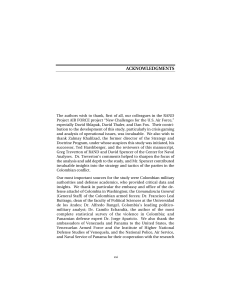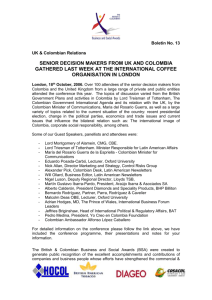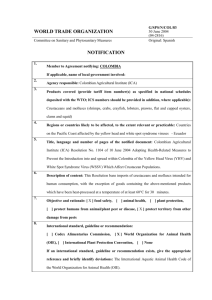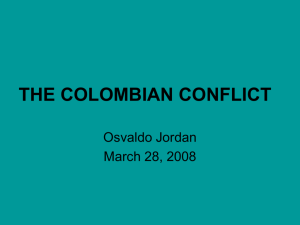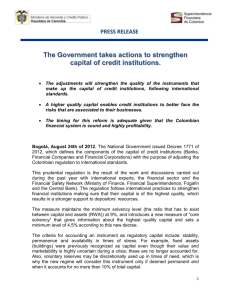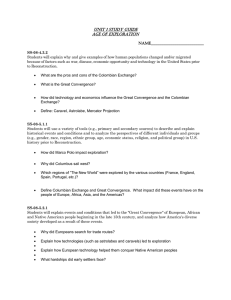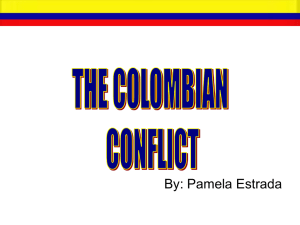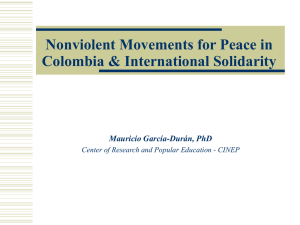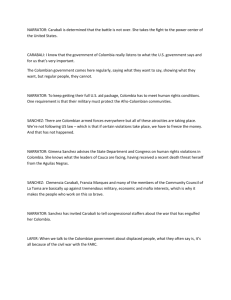THE COLOMBIAN ARMED FORCES MILITARY REFORM
advertisement
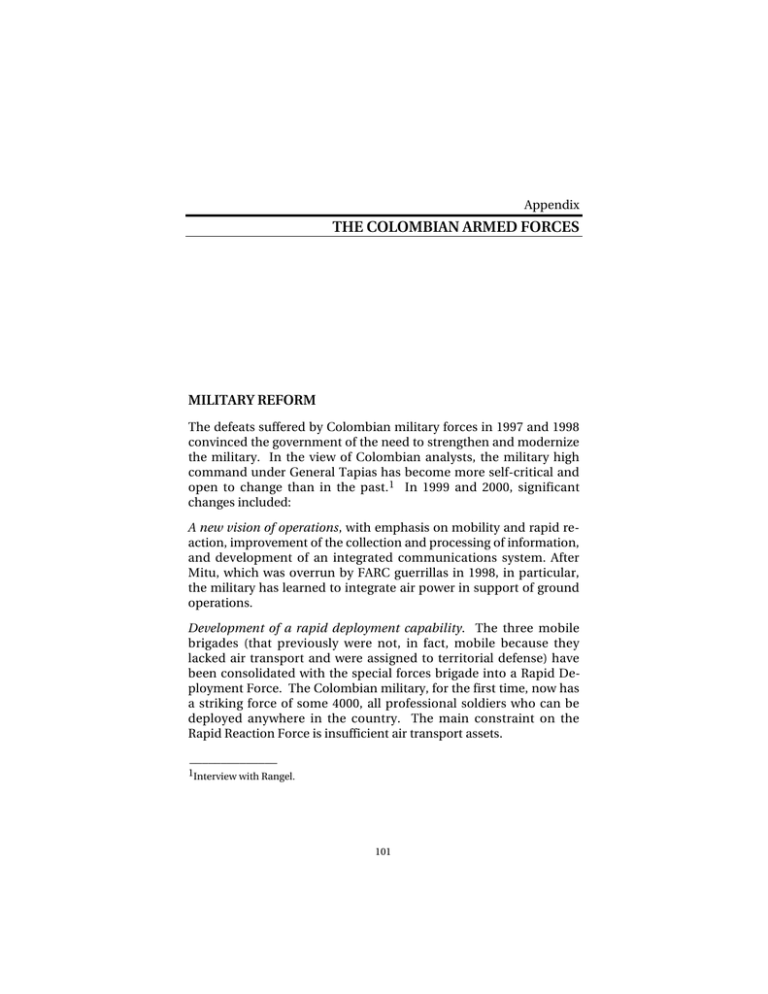
Appendix THE COLOMBIAN ARMED FORCES MILITARY REFORM The defeats suffered by Colombian military forces in 1997 and 1998 convinced the government of the need to strengthen and modernize the military. In the view of Colombian analysts, the military high command under General Tapias has become more self-critical and open to change than in the past. 1 In 1999 and 2000, significant changes included: A new vision of operations, with emphasis on mobility and rapid reaction, improvement of the collection and processing of information, and development of an integrated communications system. After Mitu, which was overrun by FARC guerrillas in 1998, in particular, the military has learned to integrate air power in support of ground operations. Development of a rapid deployment capability. The three mobile brigades (that previously were not, in fact, mobile because they lacked air transport and were assigned to territorial defense) have been consolidated with the special forces brigade into a Rapid Deployment Force. The Colombian military, for the first time, now has a striking force of some 4000, all professional soldiers who can be deployed anywhere in the country. The main constraint on the Rapid Reaction Force is insufficient air transport assets. ______________ 1Interview with Rangel. 101 102 Colombian Labyrinth Improvements in the employment of air power. In addition to betterintegrated operations with the land forces, the air force is now able to conduct night operations using night-vision equipment. Improvements in intelligence collection. Better training and equipment has provided the Colombian military with improved signals intelligence (SIGINT). Human intelligence (HUMINT), a critical factor, remains difficult to remedy in guerrilla areas because of the guerrillas’ familiarity with the terrain and network of social control. Efforts to inculcate respect for human rights and customary international humanitarian law. Members of the military and the police at all levels receive an average of 90 hours a year in training in human rights and international humanitarian law.2 The Colombian government has brought to justice officers and NCOs accused of complicity in human rights violations.3 The new operational and tactical approaches of the Colombian military have produced some results, as noted in Chapter Four. However, there is a need for caution in reaching any conclusions. The military situation remains dynamic and there is not enough evidence that the military can control the guerrillas. The Colombian military has the advantage in numbers and firepower, but the guerrillas maintain the operational and tactical initiative. In the majority of encounters, the guerrillas choose the time and place of attack. In Vigía del Fuente, Chocó, in March–April 2000, and in Arboleda, Caldas, in August 2000, the guerrillas attacked and destroyed fortified police posts, while the army was unable to send reinforcements in time to save the besieged police units. Moreover, the ability of guerrillas to adjust should not be underestimated. In the case of El Salvador, the FMLN adjusted to the increased mobility and air power of the Salvadoran military by introducing portable surface-to-air missiles, making greater use of an______________ 2La fuerza pública y los derechos humanos en Colombia, p. 27. 3Colombian officers point out that in almost all the cases the accusations regard acts of omission, that is, failing to prevent killings by irregular forces in their area of responsibility rather than active participation in these incidents. The question is whether the commanders responsible for areas where atrocities occurred lacked the means or opportunity to prevent the incidents (as some of the accused claim), chose to ignore them, or abetted the perpetrators. The Colombian Armed Forces 103 tipersonnel mines, and scaling down the size of their military formations.4 They also moved from mobile to intense attrition warfare.5 Given the importance of air in Colombian military strategy, the use of surface-to-air missiles by the guerrillas could change the strategic balance by forcing the Colombian military to curtail air operations and rely on land transport for troop movements. FORCE POSTURE At this writing, about one third of the Colombian military’s 144,000 total strength is in training or defending fixed installations. Another 13 percent are defending 842 critical infrastructure points, such as bridges, roads, the communications network, oil and electrical installations, and airports. Some 5 percent are deployed as border guards. This leaves somewhat less than half of the standing force available for operations.6 The new doctrine emphasizes mobility and a shift from a defensive to an offensive posture. To implement Plan Colombia’s counternarcotics military component, the army is creating three new counter-narcotics battalions that are at the heart of the Plan’s military component. The new counter-narcotics battalions will be more proficient than the regular battalions, but will also present more lucrative targets for the guerrillas. At the same time, the guerrillas’ attacks on small towns and isolated police stations are increasing the army’s requirement to provide static defense. According to Colombian military figures, there is an unmet requirement for police and military protection of 254 municipios and corregimientos, one fourth of the total number.7 MOBILITY Mobility is the key to the Colombian military strategy. Only by being able to bring reinforcements rapidly can the Colombian military ______________ 4Steve Salisbury, “Guerras diferentes,” Semana, September 13, 2000. 5Personal communication from David Spencer, December 2000. 6Colombian armed forces briefing, April 2000. 7Ibid. 104 Colombian Labyrinth neutralize the guerrillas’ operational and tactical advantages. Mobility means air transport, because the guerrillas are able to mine the roads (where they exist) that military convoys must traverse to reach threatened points. Yet, to cover a country of 1.4 million square kilometers and 6,322 kilometers of territorial borders, the Colombian military has only 25 heavy transport helicopters, of which 17 are operational. 8 U.S. assistance to Plan Colombia provides an additional 30 UH-60 Black Hawk and 33 UH-1H Huey transport helicopters, yet to be delivered. Use of these assets, however, is restricted to counter-narcotics operations. After the bloody FARC attack on the Arboleda police outpost in July 2000, the U.S. Embassy in Bogotá was obliged to defend the Colombians’ use of U.S.provided helicopters to reach the outpost by arguing that they could be used to defend government forces under attack in an area where there were counter-narcotics activities.9 RECRUITMENT The Colombian armed forces have a professional component, currently 30.9 percent of the force. The remaining 69.1 percent are draftees who serve for 12 to 18 months. Of this number, 50.1 percent have not completed high school, and 19.0 percent are bachilleres, or high-school graduates.10 However, according to Colombian law, high school graduates are exempted from combat duty. As a result, draftees from lower-class sectors of society have borne the brunt of the fighting, introducing an invidious element of class privilege into the Colombian government’s military effort. As General Tapias explained in a conversation with one of the authors, the Colombian military’s goal is to move to a 50 percent volunteer force by 2001, and eventually to an all-volunteer force.11 This will also require improvements in the quality of life, level of education, and training and evaluation methods. The problem, as with the ______________ 8Colombian armed forces briefing, April 2000. 9“Colombian Rebels Besiege Town,” New York Times, July 31, 2000. 10Colombian armed forces briefing, April 2000. 11Conversation with General Tapias, Bogotá, April 2000. The Colombian Armed Forces 105 rest of the military’s professionalization and modernization plans, is whether the resources are available for implementation. MILITARY BUDGET The budget for Colombia’s military and police is 4500 billion pesos (U.S. $2.5 billion at an exchange rate of 1820 pesos to the dollar). As a proportion of GDP (3.56 percent), the amount allocated to defense and security has not changed substantially over the past decade, as shown in Table A.1. Although Colombian military and police expenditures as a proportion of GDP are higher than the average for Latin America, such a level of expenditures is nevertheless low for a country fighting an active insurgency. Table A.1 Colombian Defense Budget Funding (in Percentage Year millions of pesos) of GDP 1990 367,139 2.34 1991 467,931 2.29 1992 701,737 2.69 1993 1,104,292 3.23 1994 1,296,202 3.11 1995 1,774,994 3.44 1996 2,500,085 3.59 1997 3,328,106 3.89 1998 3,756,476 3.59 1999 4,437,311 4.03 2000 4,501,706 3.56 SOURCE: Colombian Ministry of Defense.
